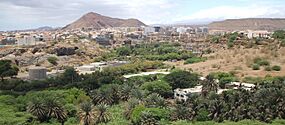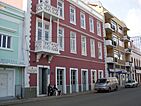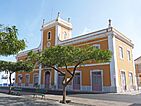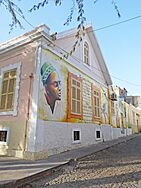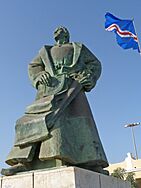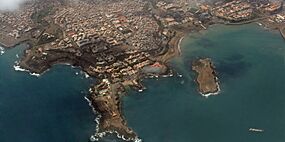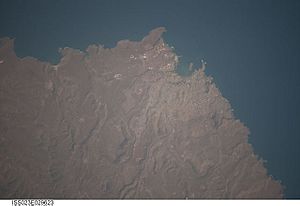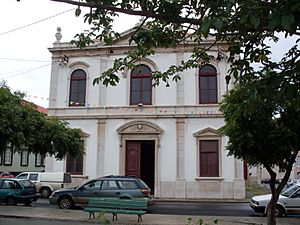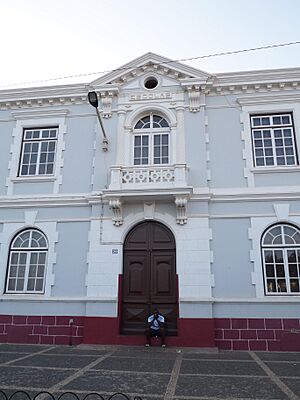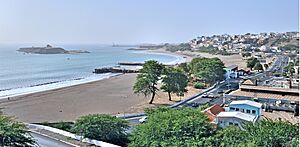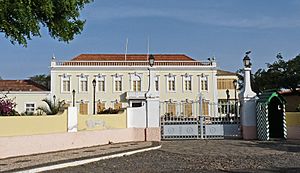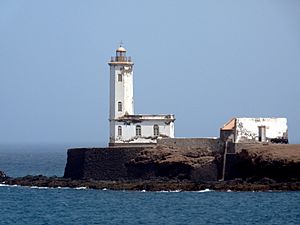Praia facts for kids
Quick facts for kids
Praia
|
|||
|---|---|---|---|
|
Clockwise: View of Monte Vermelho; Praia City Hall; Monumento de Diogo Gomes; aerial view of Praia; Fundação Amílcar Cabral; Palácio da Cultura Ildo Lobo.
|
|||
|
|||
| Island | Santiago | ||
| Municipality | Praia | ||
| Civil Parish | Nossa Senhora da Graça | ||
| Founded | 16th century | ||
| City | 1858 | ||
| Area | |||
| • Total | 102.6 km2 (39.6 sq mi) | ||
| Population
(2017 estimate)
|
|||
| • Total | 159,050 | ||
| • Density | 1,550.2/km2 (4,015.0/sq mi) | ||
| Time zone | UTC-01:00 (Cape Verde Time) | ||
| • Summer (DST) | (Not Observed) | ||
Praia is the capital and largest city of Cape Verde. Its name means "beach" in Portuguese. This important city is located on the southern coast of Santiago island. Santiago is part of the Sotavento Islands group. Praia is the main center for politics, economy, and culture in Cape Verde.
Contents
History of Praia
Santiago island was found by António da Noli in 1460. The first town there was Ribeira Grande, now called Cidade Velha. The small village of Praia de Santa Maria was first mentioned around 1615. It grew near a natural harbor.
The ports on Santiago were very important stops for ships. These ships traveled between Portugal and its colonies in Africa and South America. From the late 1500s to the late 1700s, both Ribeira Grande and Praia faced many pirate attacks. Famous pirates like Francis Drake attacked them.
Praia was built on a high flat area called a plateau. This made it safer from pirate attacks than Ribeira Grande. Because of this, Praia slowly became the most important place in Cape Verde. It became the capital in 1770.
A naval battle, the Battle of Porto Praya, happened in Praia's harbor on April 16, 1781. Even though Portugal was neutral, the battle was between Great Britain and France. It ended with no clear winner, but France gained a strategic advantage. Charles Darwin visited Praia in 1832 on his famous voyage with the ship HMS Beagle.
In the 1800s, the central area of Praia, called the Plateau, was rebuilt. Streets were laid out in a grid pattern. Grand colonial buildings and mansions were built there. Praia officially became a city in 1858. This made its role as the capital even stronger, bringing together political, religious, and economic power. By the early 1920s, about 21,000 people lived in Praia.
People in Cape Verde started to resist Portuguese rule in the 1950s. Unlike some other places, there wasn't a big war for independence. After a revolution in Portugal in 1974, Cape Verde became independent in July 1975.
After independence, many people moved to Praia from other islands. This caused the city to grow very quickly. Today, more than half of Cape Verde's population lives on Santiago island. About 29% of the country's population lives in the Municipality of Praia. In 2015, the city's population was estimated to be 151,436. In 1985, Praia joined a group called the Union of Luso – Afro-Americo-Asiatic Capital Cities.
Geography and Climate
Praia is made up of several flat, high areas called plateaus and the valleys around them. These plateaus are often called achada, which is a Portuguese word for a volcanic plateau. The main central plateau is simply called the Plateau. Most of the city is built on these plateaus and in the valleys. There's also a small island called Ilhéu de Santa Maria near the beach.
For a long time, only the Plateau was seen as the actual city. Other neighborhoods were considered suburbs, even though they were closely connected. The Plateau had good roads and buildings, but other areas grew more randomly. After Cape Verde became independent, the Plateau and other neighborhoods officially became one city. The whole city then received better infrastructure.
Praia's Weather
Praia has a desert climate. This means it has a very short wet season and a long, very dry season. Most of the rain falls in August, September, and October. On average, Praia gets about 210 millimeters (8.3 inches) of rain each year.
Even though it's a desert climate, Praia doesn't get extremely hot or cold. This is because it's located by the ocean on Santiago Island. Temperatures are usually warm and steady. The average high temperature is about 27°C (81°F), and the average low is about 22°C (72°F).
| Climate data for Praia (Nelson Mandela International Airport) 1991–2020 | |||||||||||||
|---|---|---|---|---|---|---|---|---|---|---|---|---|---|
| Month | Jan | Feb | Mar | Apr | May | Jun | Jul | Aug | Sep | Oct | Nov | Dec | Year |
| Record high °C (°F) | 31.9 (89.4) |
33.1 (91.6) |
34.2 (93.6) |
33.4 (92.1) |
33.3 (91.9) |
34.1 (93.4) |
32.5 (90.5) |
33.1 (91.6) |
36.2 (97.2) |
34.8 (94.6) |
33.0 (91.4) |
31.0 (87.8) |
36.2 (97.2) |
| Mean daily maximum °C (°F) | 26.7 (80.1) |
26.9 (80.4) |
27.8 (82.0) |
28.1 (82.6) |
28.7 (83.7) |
29.5 (85.1) |
29.7 (85.5) |
30.5 (86.9) |
30.8 (87.4) |
31.0 (87.8) |
29.8 (85.6) |
27.8 (82.0) |
28.9 (84.0) |
| Daily mean °C (°F) | 23.2 (73.8) |
23.2 (73.8) |
23.8 (74.8) |
24.2 (75.6) |
24.8 (76.6) |
25.7 (78.3) |
26.4 (79.5) |
27.4 (81.3) |
27.6 (81.7) |
27.5 (81.5) |
26.3 (79.3) |
24.4 (75.9) |
25.4 (77.7) |
| Mean daily minimum °C (°F) | 19.8 (67.6) |
19.5 (67.1) |
19.8 (67.6) |
20.3 (68.5) |
20.9 (69.6) |
21.9 (71.4) |
23.1 (73.6) |
24.2 (75.6) |
24.4 (75.9) |
23.9 (75.0) |
22.8 (73.0) |
21.1 (70.0) |
21.8 (71.2) |
| Record low °C (°F) | 16.9 (62.4) |
16.2 (61.2) |
16.5 (61.7) |
17.0 (62.6) |
18.8 (65.8) |
19.2 (66.6) |
20.3 (68.5) |
20.6 (69.1) |
19.6 (67.3) |
19.6 (67.3) |
19.5 (67.1) |
17.3 (63.1) |
16.2 (61.2) |
| Average precipitation mm (inches) | 0.8 (0.03) |
0.4 (0.02) |
0.1 (0.00) |
0.0 (0.0) |
0.3 (0.01) |
0.0 (0.0) |
5.9 (0.23) |
54.6 (2.15) |
75.3 (2.96) |
27.2 (1.07) |
4.4 (0.17) |
7.9 (0.31) |
176.9 (6.95) |
| Average precipitation days (≥ 0.1 mm) | 0.2 | 0.1 | 0 | 0 | 0 | 0 | 0.9 | 4.0 | 5.0 | 1.8 | 0.2 | 0.2 | 12.4 |
| Average relative humidity (%) | 65.7 | 63.3 | 62.6 | 64.5 | 65.2 | 68.5 | 73.3 | 76.0 | 76.8 | 72.9 | 69.8 | 70.1 | 69.1 |
| Mean monthly sunshine hours | 223.2 | 234.5 | 279.0 | 285.0 | 306.9 | 279.0 | 217.0 | 201.5 | 216.0 | 244.9 | 234.0 | 204.6 | 2,925.6 |
| Mean daily sunshine hours | 7.2 | 8.3 | 9.0 | 9.5 | 9.9 | 9.3 | 7.0 | 6.5 | 7.2 | 7.9 | 7.8 | 6.6 | 8.0 |
| Source 1: NOAA, Instituto Nacional de Meteorologia e Geofísica (humidity 1981-2010) | |||||||||||||
| Source 2: Deutscher Wetterdienst (extremes, sun) | |||||||||||||
People of Praia
In July 2017, about 159,050 people lived in Praia. Back in the mid-1800s, the population was much smaller, around 1,500 to 2,000 people.
| Population of the city of Praia (1990–2017) | ||
|---|---|---|
| Year | Pop. | ±% |
| 1990 | 61,644 | — |
| 2000 | 94,161 | +52.7% |
| 2010 | 130,271 | +38.3% |
| 2017 | 159,050 | +22.1% |
| Source: City Population, citing the Instituto Nacional de Estatísticas . | ||
Education in Praia
Praia is home to the very first primary school in Cape Verde. It was first called the Escola Central and is now known as the Escola Grande. For a long time, this was the only primary school in Praia. In the early 1960s, more primary schools started to be built in other neighborhoods.
Praia also had the first secondary school in Cape Verde, opened in 1861. However, this school didn't last. Secondary education later moved to other islands. In 1960, Praia got secondary education back. As education grew in Cape Verde in the 1990s, many new school buildings were built. By 2016, Praia had 12 secondary schools.
There are also international schools in Praia:
- École Internationale Les Alizés (a French school)
- Colégio Internacional – Cabo Verde (a Portuguese school)
For higher education, students can attend several universities and institutes:
- Universidade de Santiago
- Instituto Superior de Ciencias Jurídicas e Sociais
- Instituto Superior de Ciencias Económicas e Empresariais
- Jean Piaget University of Cape Verde
- University of Cape Verde
Praia is also where you'll find the National Library of Cape Verde and the National Archives Building.
Economy of Praia
Most of Praia's economy comes from the service industry. This includes things like government work, trade, healthcare, education, and tourism. Many people also work in restaurants, hotels, and other public services.
As the capital and economic center, Praia is one of the most active cities in Cape Verde. About one-third of the city's population lived below the poverty line in 2014. The total economic output of the city is about 39% of Cape Verde's entire economy. This means the average income per person in Praia is about US$4,764.
Transportation in Praia
Praia has its own airport, Nelson Mandela International Airport. Cabo Verde Airlines also has its main office here. Praia's port, Praia Harbor, is the second busiest in the country. It has a ferry terminal that connects to other islands like Maio, Fogo, and São Vicente. The port was updated and made bigger in 2014.
The city has a dual carriageway ring road called the Circular da Praia. This road connects to the main national roads that go north and west on the island. Important roads inside the city include Avenida Grão Ducado de Luxemburgo and Avenida Amílcar Cabral.
Getting Around the City
Public buses in Praia are run by a company called SolAtlântico. There are 12 different bus routes in the city. For traveling to other towns on Santiago island, you can find shared taxis at the Sucupira terminal. This terminal opened in May 2018. A project called EcobusCV started in 2015, using special minibuses that ran on cooking oil and diesel. However, these services stopped in 2016.
Culture and Landmarks
Praia has the Museu Etnográfico (Ethnographic Museum), which opened in 1997. Some of the oldest buildings include the Jaime Mota Barracks, built in 1826. Since 2016, the historic center of Praia has been considered for a World Heritage Site listing.
Important landmarks in the old city center include:
- Albuquerque Square: Named after a governor from the 1800s.
- Old City Hall: Built in the 1920s.
- Presidential Palace: Built in the late 1800s for the Portuguese governor.
- Monumento de Diogo Gomes: A monument named after the Portuguese explorer who found Santiago island in 1460.
Places of Worship
Most places of worship in Praia are Christian churches. These include:
- Roman Catholic Diocese of Santiago de Cabo Verde (Catholic Church)
- Church of Jesus Christ of Latter-day Saints
- Church of the Nazarene
- Universal Church of the Kingdom of God
- Assemblies of God
Sports in Praia
Praia is home to many sports teams, especially football (soccer) clubs. Some popular football clubs are Sporting, Boavista, Travadores, and Académica. Other clubs include ADESBA and Celtic.
Basketball clubs include ABC Praia, Bairro, and Travadores. There's also a volleyball club called Desportivo da Praia. Many of these teams play at the Estádio da Várzea stadium.
Famous People from Praia
- Caló, a football player
- Arménio Vieira, a writer
- Gelson Fernandes, a football player
- Ivan Almeida, a basketball player
- Tania Fernandes Anderson, an American politician born in Cape Verde
- Vadú, a singer
International Connections
Praia is connected with other cities around the world as "sister cities". This means they share cultural and economic ties.
 Boston, United States
Boston, United States Faro, Portugal
Faro, Portugal Figueira da Foz, Portugal
Figueira da Foz, Portugal Funchal, Portugal
Funchal, Portugal Gondomar, Portugal
Gondomar, Portugal Jinan, China
Jinan, China Lisbon, Portugal
Lisbon, Portugal Macau, China
Macau, China Ponta Delgada, Portugal
Ponta Delgada, Portugal Providence, United States
Providence, United States
See also
 In Spanish: Praia para niños
In Spanish: Praia para niños


